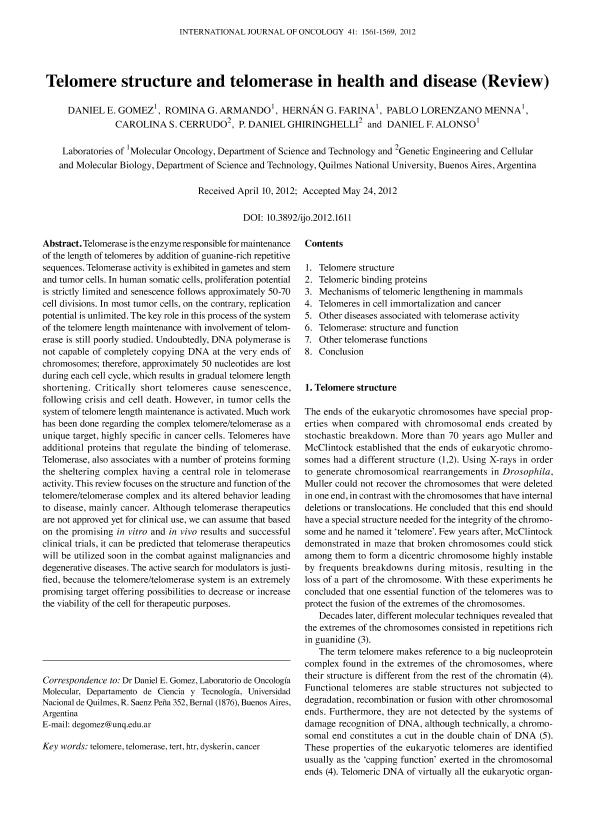Mostrar el registro sencillo del ítem
dc.contributor.author
Gomez, Daniel Eduardo

dc.contributor.author
Armando, Romina Gabriela

dc.contributor.author
Farina, Hernán Gabriel

dc.contributor.author
Lorenzano Menna, Pablo

dc.contributor.author
Cerrudo, Carolina Susana

dc.contributor.author
Ghiringhelli, Pablo Daniel

dc.contributor.author
Alonso, Daniel Fernando

dc.date.available
2023-06-05T15:12:46Z
dc.date.issued
2012-11
dc.identifier.citation
Gomez, Daniel Eduardo; Armando, Romina Gabriela; Farina, Hernán Gabriel; Lorenzano Menna, Pablo; Cerrudo, Carolina Susana; et al.; Telomere structure and telomerase in health and disease; Spandidos Publications; International Journal of Oncology; 41; 5; 11-2012; 1561-1569
dc.identifier.issn
1019-6439
dc.identifier.uri
http://hdl.handle.net/11336/199560
dc.description.abstract
Telomerase is the enzyme responsible for maintenance of the length of telomeres by addition of guanine-rich repetitive sequences. Telomerase activity is exhibited in gametes and stem and tumor cells. In human somatic cells, proliferation potential is strictly limited and senescence follows approximately 50-70 cell divisions. In most tumor cells, on the contrary, replication potential is unlimited. The key role in this process of the system of the telomere length maintenance with involvement of telomerase is still poorly studied. Undoubtedly, DNA polymerase is not capable of completely copying DNA at the very ends of chromosomes; therefore, approximately 50 nucleotides are lost during each cell cycle, which results in gradual telomere length shortening. Critically short telomeres cause senescence, following crisis and cell death. However, in tumor cells the system of telomere length maintenance is activated. Much work has been done regarding the complex telomere/telomerase as a unique target, highly specific in cancer cells. Telomeres have additional proteins that regulate the binding of telomerase. Telomerase, also associates with a number of proteins forming the sheltering complex having a central role in telomerase activity. This review focuses on the structure and function of the telomere/telomerase complex and its altered behavior leading to disease, mainly cancer. Although telomerase therapeutics are not approved yet for clinical use, we can assume that based on the promising in vitro and in vivo results and successful clinical trials, it can be predicted that telomerase therapeutics will be utilized soon in the combat against malignancies and degenerative diseases. The active search for modulators is justified, because the telomere/telomerase system is an extremely promising target offering possibilities to decrease or increase the viability of the cell for therapeutic purposes.
dc.format
application/pdf
dc.language.iso
eng
dc.publisher
Spandidos Publications

dc.rights
info:eu-repo/semantics/openAccess
dc.rights.uri
https://creativecommons.org/licenses/by-nc-sa/2.5/ar/
dc.subject
TELOMERASE
dc.subject
TELOMERE
dc.subject
COMPLEX
dc.subject
DISEASE
dc.subject.classification
Tecnologías que involucran la identificación de ADN, proteínas y enzimas, y cómo influyen en el conjunto de enfermedades y mantenimiento del bienestar

dc.subject.classification
Biotecnología de la Salud

dc.subject.classification
CIENCIAS MÉDICAS Y DE LA SALUD

dc.title
Telomere structure and telomerase in health and disease
dc.type
info:eu-repo/semantics/article
dc.type
info:ar-repo/semantics/artículo
dc.type
info:eu-repo/semantics/publishedVersion
dc.date.updated
2023-05-24T16:56:44Z
dc.journal.volume
41
dc.journal.number
5
dc.journal.pagination
1561-1569
dc.journal.pais
Grecia

dc.journal.ciudad
Atenas
dc.description.fil
Fil: Gomez, Daniel Eduardo. Consejo Nacional de Investigaciones Científicas y Técnicas; Argentina. Universidad Nacional de Quilmes. Departamento de Ciencia y Tecnología. Laboratorio de Oncología Molecular; Argentina
dc.description.fil
Fil: Armando, Romina Gabriela. Consejo Nacional de Investigaciones Científicas y Técnicas; Argentina. Universidad Nacional de Quilmes. Departamento de Ciencia y Tecnología. Laboratorio de Oncología Molecular; Argentina
dc.description.fil
Fil: Farina, Hernán Gabriel. Consejo Nacional de Investigaciones Científicas y Técnicas; Argentina. Universidad Nacional de Quilmes. Departamento de Ciencia y Tecnología. Laboratorio de Oncología Molecular; Argentina
dc.description.fil
Fil: Lorenzano Menna, Pablo. Consejo Nacional de Investigaciones Científicas y Técnicas; Argentina. Universidad Nacional de Quilmes. Departamento de Ciencia y Tecnología. Laboratorio de Oncología Molecular; Argentina
dc.description.fil
Fil: Cerrudo, Carolina Susana. Consejo Nacional de Investigaciones Científicas y Técnicas; Argentina. Universidad Nacional de Quilmes. Departamento de Ciencia y Tecnología. Laboratorio de Ingeniería Genética y Biología Molecular y Celular; Argentina
dc.description.fil
Fil: Ghiringhelli, Pablo Daniel. Consejo Nacional de Investigaciones Científicas y Técnicas; Argentina. Universidad Nacional de Quilmes. Departamento de Ciencia y Tecnología. Laboratorio de Ingeniería Genética y Biología Molecular y Celular; Argentina
dc.description.fil
Fil: Alonso, Daniel Fernando. Consejo Nacional de Investigaciones Científicas y Técnicas; Argentina. Universidad Nacional de Quilmes. Departamento de Ciencia y Tecnología. Laboratorio de Oncología Molecular; Argentina
dc.journal.title
International Journal of Oncology

dc.relation.alternativeid
info:eu-repo/semantics/altIdentifier/url/https://www.spandidos-publications.com/10.3892/ijo.2012.1611/
dc.relation.alternativeid
info:eu-repo/semantics/altIdentifier/doi/https://doi.org/10.3892/ijo.2012.1611
Archivos asociados
